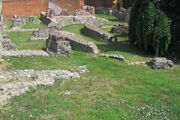The Edict of Milan was a letter signed by emperors Constantine and Licinius that proclaimed religious toleration in the Roman Empire. The letter was issued in 313 AD, shortly after the conclusion of the Diocletian Persecution.
History[]
The Edict of Milan was issued in 313 AD, in the names of the Roman Emperors Constantine the Great (Constantine I), who ruled the western parts of the Empire, and Licinius, who ruled the east. The two augusti were in Milan to celebrate the wedding of Constantine's sister with Licinius.

Remains of the Imperial palace of Mediolanum (Milan). The imperial palace (mainly built by Maximian, colleague of Diocletian) was a large complex with several buildings, gardens, courtyards, for Emperor's private and public life, for his court, family and imperial bureaucracy
A previous edict of toleration had been recently issued by the emperor Galerius from Serdica and posted up at Nicomedia on 13, May 311. By its provisions, the Christians, who had "followed such a caprice and had fallen into such a folly that they would not obey the institutes of antiquity", were granted an indulgence.
Wherefore, for this our indulgence, they ought to pray to their God for our safety, for that of the republic, and for their own, that the commonwealth may continue uninjured on every side, and that they may be able to live securely in their homes.
By the Edict of Milan the meeting places and other properties which had been confiscated from the Christians and sold or granted out of the government treasury were to be returned:
...the same shall be restored to the Christians without payment or any claim of recompense and without any kind of fraud or deception...
It directed the provincial magistrates to execute this order at once with all energy, so that public order may be restored and the continuance of the Divine favor may "preserve and prosper our successes together with the good of the state."
The actual edicts have not been retrieved inscribed upon stone. However, they are quoted at length in a historical work with a theme of divine retribution, Lactantius' De mortibus persecutorum ("Deaths of the persecutors"), who gives the Latin text of both Galerius's Edict of Toleration as posted up at Nicomedia on 30 April 311 AD, and of Licinius's letter of toleration and restitution addressed to the governor of Bithynia, posted up also at Nicomedia on 13 June 313 AD. Eusebius of Caesarea translated both into Greek in his History of the Church (Historia Ecclesiastica). His version of the letter of Licinius must derive from a copy as posted up in Palestine (probably at Caesarea) in the late summer or early autumn of 313 AD, but the origin of his copy of Galerius's edit of 311 AD is unknown, since that does not seem to have been promulgated in Palestine.
See also[]
- Constantine I and Christianity
- Constantinian shift
- List of treaties
- Edict of toleration
External links[]
- Medieval Sourcebook - Galerius and Constantine: Edicts of Toleration 311 and 313
- The Roman Law Library, incl. Constitutiones Principis
| This page uses Creative Commons Licensed content from Wikipedia (view authors). |